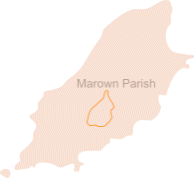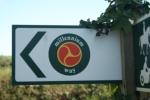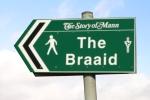Marown Parish

The Marown Parish is dedicated to St Runius or Ronan (Ma-Ronan) and it is thought that originally Marown and Santon were a single parish but the division had occurred by the 14th Century.
Marown is the only parish in the Isle of Man with no coastline. It covers an area of 26.7 square kilometres (10.3 square miles) and at the time of the 2006 census had a population of 2,086. The population density of Marown, at 70.5 people per square kilometre (202.5 per square mile), is much lower than any of the towns or villages but is the second highest of any parish (after Arbory).
Latest Marown Parish Photographs
The population of Marown is balanced in terms of age and gender. 25.4% of the parish residents are aged under 20 years and 22.3% are over 60. 50.1% of parish residents are male and 49.9% female. The number of private households in Marown in 2006 was 811, up from 744 in 2001. 170 people (over 8%) lived alone but the average number of people per household was 2.57. 633 households (over 78%) lived in detached houses.
When it comes to employment, Marown could be described as a commuter zone or even a dormitory settlement. In 2006, 1,019 Marown residents (48.8%) were in employment (567 males, 452 females) but the parish only provided 349 jobs. 61% of the people of Marown worked in Douglas.
Marown is a relatively prosperous area of the Island. The 2001 census showed that over 78% of households lived in detached houses, 82% owned their own home, 94.4% of households had a vehicle and 94.2% had central heating. 76% of the employed people of Marown drove themselves to work on most days and just 5% travelled to work by public transport.

The Millennium Way
The Millennium Way was established in 1979 to mark one thousand years of continuous Parliament (Tynwald) in the Isle of Man. It is a long distance walk of approximately 26 miles from Ramsey to Castletown. The walk is based on an ancient ridgeway route which was known as "Via Regia" the Royal Way, along which the former Kings of Man travelled to Castletown, the Isle of Man's former capital.
Millennium Way Sign
It can be walked from Sky Hill in the north (one mile from Ramsey on the main road to Kirk Michael) to Castle Rushen in the south in one day or split into two convenient sections ending or starting at Crosby. The route enters Marown parish at West Baldwin bridge and continues down Eyreton Road into Crosby where it crosses the Douglas to Peel road and continues along Old Church Road. It follows the road up School Hill and past the old St Runius church. The way then crosses Foxdale Road and carries on to St Marks in Malew.
The Millennium Way passes through some of the most scenic routes of the Isle of Man and has proved to be a great success, the northern section attracting hill walking enthusiasts from all over Britain and Europe. The route is signposted.
Heritage Trail
This path follows the route of the disused Douglas to Peel railway line. The Heritage trail is a 10.5 (17kms) walk from the Quarterbridge in Douglas through to Peel ending near the car park for the House of Manannan (partly built out of the old railway station). Information signs are posted about the path as well as picnic stops. Refreshment can be obtained from some of the main villages on the trail like Crosby and St Johns.
The Heritage trail can be easily accessed in Marown via Glen Darragh Road in Glen Vine or Old Church Road in Crosby. Old stone crossing huts mark the location of the former railway.
Old St Runius Church
The ancient parish church of St Runius, Marown is situated roughly in the centre of the Parish. The original building dates from around 1200 AD and was enlarged in 1754 AD. Three bishops are possibly buried here; Lonnan, Connaghan, and Runius. The old church was replaced around 1859, when a new church was opened. The building was restored by volunteer labour and reopened in 1959. Services are now held during the summer and for all major festivals.
Located near Crosby on The Garth Road beyond School Hill on the right side.of the road.

St Patrick's Chair
A small group of standing stones representing an early Christian meeting place and named after St Patrick, as some believed he use to preach from the spot. Follow the sign on the right on The Garth Road beyond School Hill in Crosby near the old St Runius church.

The Braaid
The Braaid is believed to have started as a stone circle site. Later it became a Norse farmstead set in a low valley, where good grazing land and climate was likely to have existed. The site consisted of a Celtic stone roundhouse and two Viking longhouses, believed to be from Iron Age, with the earlier Neolithical or Bronze Age periods for the stone circle site not ruled out.
The Vikings sometimes built their houses on sites already chosen by the Celts. It is not know if the local Celts were living in the roundhouse when the Vikings arrived
The Braaid has the best above ground preserved site on the Isle of Man for a settlement from this period. Located between Douglas and Foxdale on Cooil Road before Braaid roundabout. A sign to the right marks the location of the path leading to The Braaid.
St. Trinian's Chapel
Ruined roofless chapel; current building is a 14th century enlargement of an earlier 12th century chapel. This chapel was never a parish church but only a chantry. It was in ruins by the 17th century and forms the subject of several tales.
Located ¾ mile west of Crosby and is clearly visible from the main Douglas to Peel road on the right when travelling towards Peel.
September 2025 - Click Here to View (PDF)
20/02/2023
Click here for more details
Help Marown Church raise funds30/11/2022
Marown Church will be hosting home made soups and cakes with tea or coffee to help raise church funds. This was previously very well attended by many folk who went to enjoy the event, then run from Foxdale Church (now closed due to major repairs needed), who wouldn't go - good company, great food a bargain feast!
Every Friday 12.30-1.30 with ample parking.
All welcome
Local Authority Elections (LEA) 202101/07/2021
Marown Commissioners (uncontested election)
Eliza Cox, Christian Henry Forbes, John Simon William Lovelady, Alison Ruth Lynch, Terence Anthony Miles
The new board will be effective from 1st August 2021 following the LEA Elections on Thursday 22nd July 2021.
Who was the first Chairman of Marown Parish Commissioners?15/12/2015
Please help..........